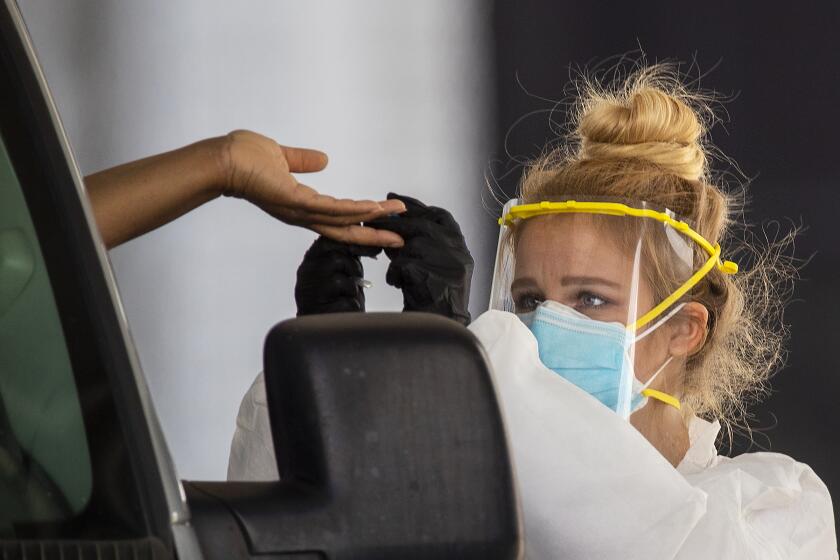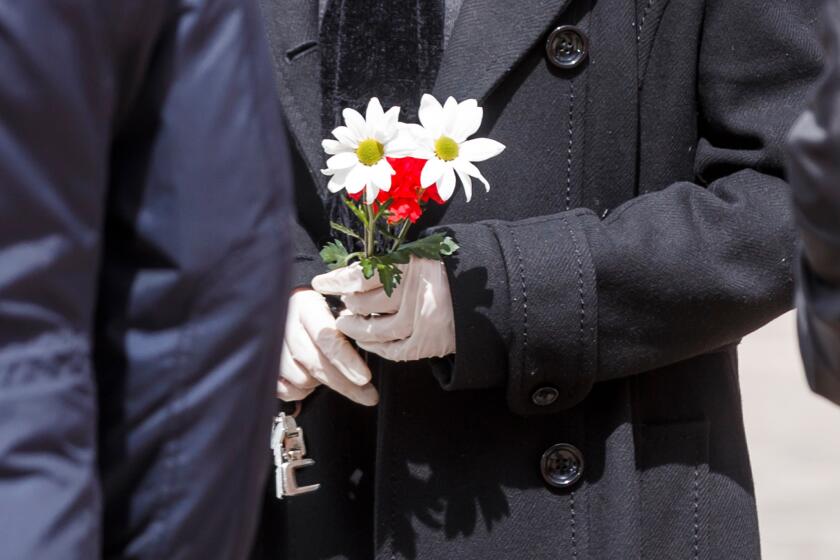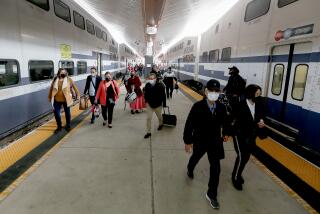25 more die in L.A. County as California coronavirus fatalities soar past 500
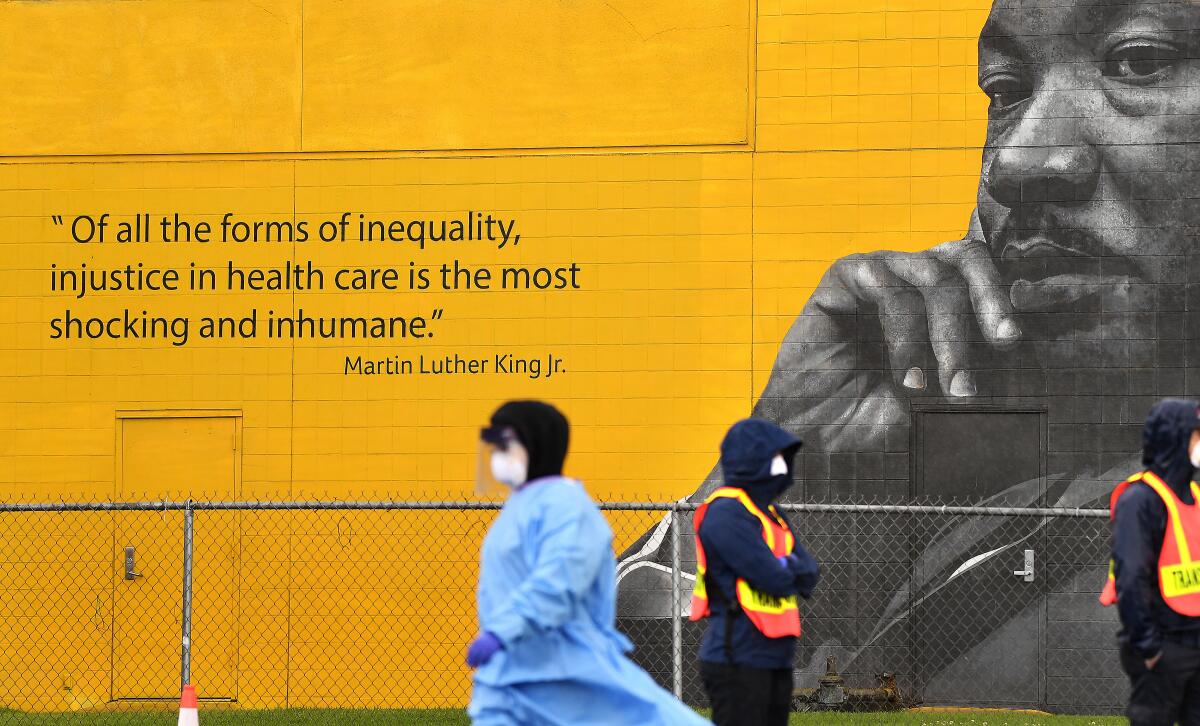
- Share via
Los Angeles County health officials announced 25 more COVID-19 deaths Thursday as the number of fatalities statewide soared past 500.
Almost one-fourth of the people who have died in L.A. County lived in nursing homes and other institutional settings, Public Health Department Director Barbara Ferrer said.
Many nursing home residents face a high risk of serious health problems or death from the coronavirus because of their age or other underlying health conditions. Ferrer said this week that it would be “perfectly appropriate” for families to remove loved ones from long-term care facilities for their safety.
In response to concerns for these residents, Los Angeles Mayor Eric Garcetti said Thursday that the city will soon deploy a rapid mobile test team to serve nursing homes, skilled-nursing facilities, assisted-living facilities and respiratory hospitals.
When facility administrators discover they have either a symptomatic client or see the start of an outbreak, they can call on the teams to help with testing the residents. The city set up a website to help those facilities, coronavirus.lacity.org/assistedliving.
“Everyone has a right to be protected in this crisis, and they shouldn’t have to fight for that right,” Garcetti said.
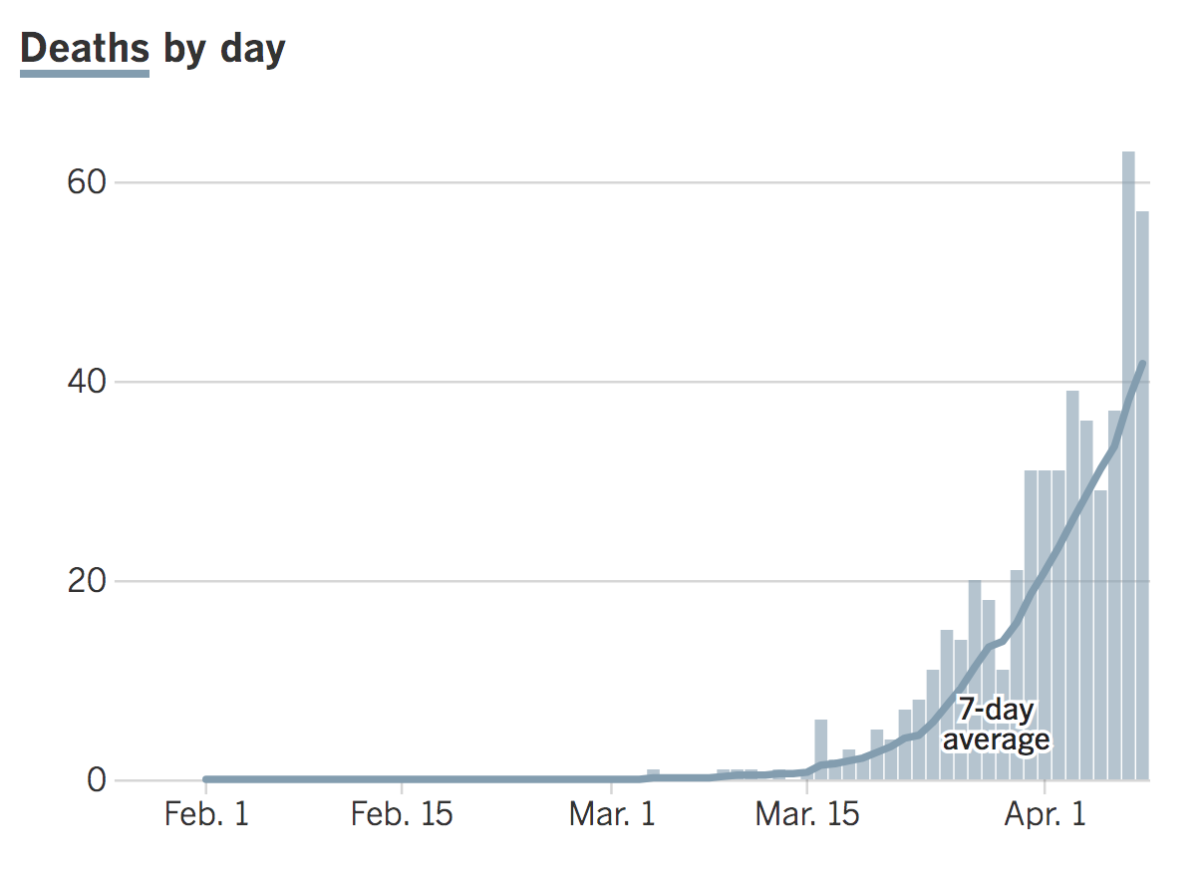
This week has been the deadliest yet for patients with the coronavirus in California, with nearly 100 deaths reported in the last two days. Fatalities have soared past 500 even as officials have voiced guarded optimism about the state’s overall outlook.
As the number of fatalities rises, the most important thing Californians can do is stay home and limit contact with other people as much as possible, officials say. Ferrer has urged residents to avoid shopping this week if they have enough to eat at home.
“Being safe means safe at home, for the next few weeks to come,” Ferrer said. “Everything we can do to avoid having to be in contact with other people is a really good idea.”
While hospitalizations in California climbed to 2,825 on Thursday, the number of COVID-19 patients in intensive care fell 1.9%, to 1,132, Gov. Gavin Newsom said.
“One data point is not a trend; one data point is not a headline, so I caution anybody to read too much into that one point of data,” Newsom said. “But, nonetheless, it is encouraging. It just again reinforces the incredible work that all of you are doing to practice physical distance. Stay-at-home is working in the state of California.”
California has not seen the death toll of virus hot spots such as New York state, where more than 7,000 people have died. While the virus continues to spread rapidly in some places, including Los Angeles County, there are signs that its rate of growth could be slowing in parts of the Bay Area.
Newsom repeated Wednesday that the duration of the stay-at-home order depends on whether Californians continue to follow it and wear appropriate face coverings if they go out.
COVID-19 deaths in the U.S. surpass 16,000. In New York, new hospitalizations slow, affirming signs that stay-at-home orders are slowing coronavirus spread.
Here is a breakdown of California counties that have reported the most deaths, from the Los Angeles Times coronavirus tracker:
- Los Angeles County 223
- Santa Clara County 46
- San Diego County 36
- Riverside County 32
- Sacramento County 22
- San Mateo County 21
- San Bernardino County 20
- Orange County 17
- Alameda County 16
- San Francisco County 10
State Sen. Holly Mitchell (D-Los Angeles) on Thursday announced that she had secured 7,500 masks for childcare workers in Los Angeles, saying that many are caring for the children of healthcare providers.
Sydnie Boylan is a nurse at Hollywood Presbyterian Medical Center who has a young daughter in childcare. On a recent shift, she said, she shared a pair of goggles with three other staff members, and, a few weeks ago, cared for a patient while not wearing full protective gear. The patient later turned out to test positive.
“When I go home, I have to undress as quickly as I can and put everything in a hot load of the washer,” she said. “Masks, I can’t even say enough, are indispensable.”
Based on an analysis of slightly more than half of the state’s COVID-19 cases, Latino residents account for 30% of cases and 25% of deaths, Newsom said. Black residents represent 7% of cases and 8% of deaths. Asian residents represent 13% of cases and 18% of deaths.
Newsom said the state planned to expand testing — including serology tests, which use a blood sample to check whether a person has developed antibodies to the virus, and community surveillance testing — to better understand when “we get back to a new normalcy.”
In a bid to stem the virus’ spread, Kaiser Permanente announced Thursday that it is temporarily closing numerous medical offices and clinics throughout Southern California.
“The health and safety of our members is always our top priority,” the healthcare network wrote in a statement on its website. “In an effort to limit additional exposure to COVID-19 throughout the community, we have decided to temporarily close or limit services. By doing this, we are able to coordinate care and combine much-needed medical equipment and staff while still providing high-quality care to our members.”
The Kaiser announcement included a list of affected locations.
The coronavirus also continues to spread in the Bay Area.
Santa Clara County, one of the hardest-hit parts of the state, is now reporting 1,380 cases and 46 deaths. The county issued an order Wednesday for individuals and businesses to report any ventilators or large inventories of personal protective equipment they have in anticipation of a forthcoming shortage.
Contra Costa County has reported 484 cases and eight deaths. In Sacramento County, there have been 613 cases and 22 deaths. In San Francisco, there have been 724 cases and 10 deaths.
Alameda County has reported 674 cases and 16 deaths. Health officials there are contending with significant outbreaks at two nursing homes.
At Gateway Care and Rehabilitation Center in Hayward, 24 staff and 35 residents have tested positive for COVID-19. Six of the residents have died.
Nine residents and 17 staff members have tested positive at East Bay Post-Acute Health Care Center in Castro Valley, but no deaths have been reported there.
In our effort to cover this pandemic as thoroughly as possible, we’d like to hear from the loved ones of people who have died from the coronavirus.
In a bid to keep people safer at home, Los Angeles County has launched a free delivery service for dependent adults, people with disabilities and anyone who is 60 or older. The service will ferry household items, groceries and other necessities to those who cannot leave their homes.
Deliveries can be scheduled by calling (888) 863-7411 between 8 a.m. and 5 p.m. on weekdays. Items can be distributed 24 hours a day, seven days a week, but clients are limited to either four deliveries or a 40-mile delivery range per month, according to the Los Angeles County Department of Workforce Development, Aging and Community Services.
“No application process is required; however, items must be prepaid and ready for pickup,” the department wrote on Facebook.
California coronavirus curve: Fewer deaths, long quarantine
For those who can leave their homes, Garcetti has ordered all residents to wear a face covering when going out on essential errands.
Starting Friday, residents must wear a mask, bandanna or other type of covering over their noses and mouths when in grocery stores, pharmacies, hardware stores, coin-operated laundry services, restaurants, hotels, taxis, ride-hail vehicles and several other essential businesses. Workers must also wear masks.
The cities of Lancaster, Carson and Beverly Hills, along with San Bernardino and Riverside counties, also have mandatory face covering orders.
Orange County Health Officer Dr. Nichole Quick didn’t go quite that far, instead issuing a recommendation Thursday “strongly encouraging all employees at essential businesses to wear a face covering while at work and all residents engaged in essential activities outside the home to do the same.”
“Face coverings are an additional tool that may help protect staff and patrons from COVID-19, but they are not a substitute for proven protective measures like frequent hand washing, keeping your hands away from your face, practicing social distancing and staying home,” she said in a statement.
More to Read
Sign up for Essential California
The most important California stories and recommendations in your inbox every morning.
You may occasionally receive promotional content from the Los Angeles Times.
